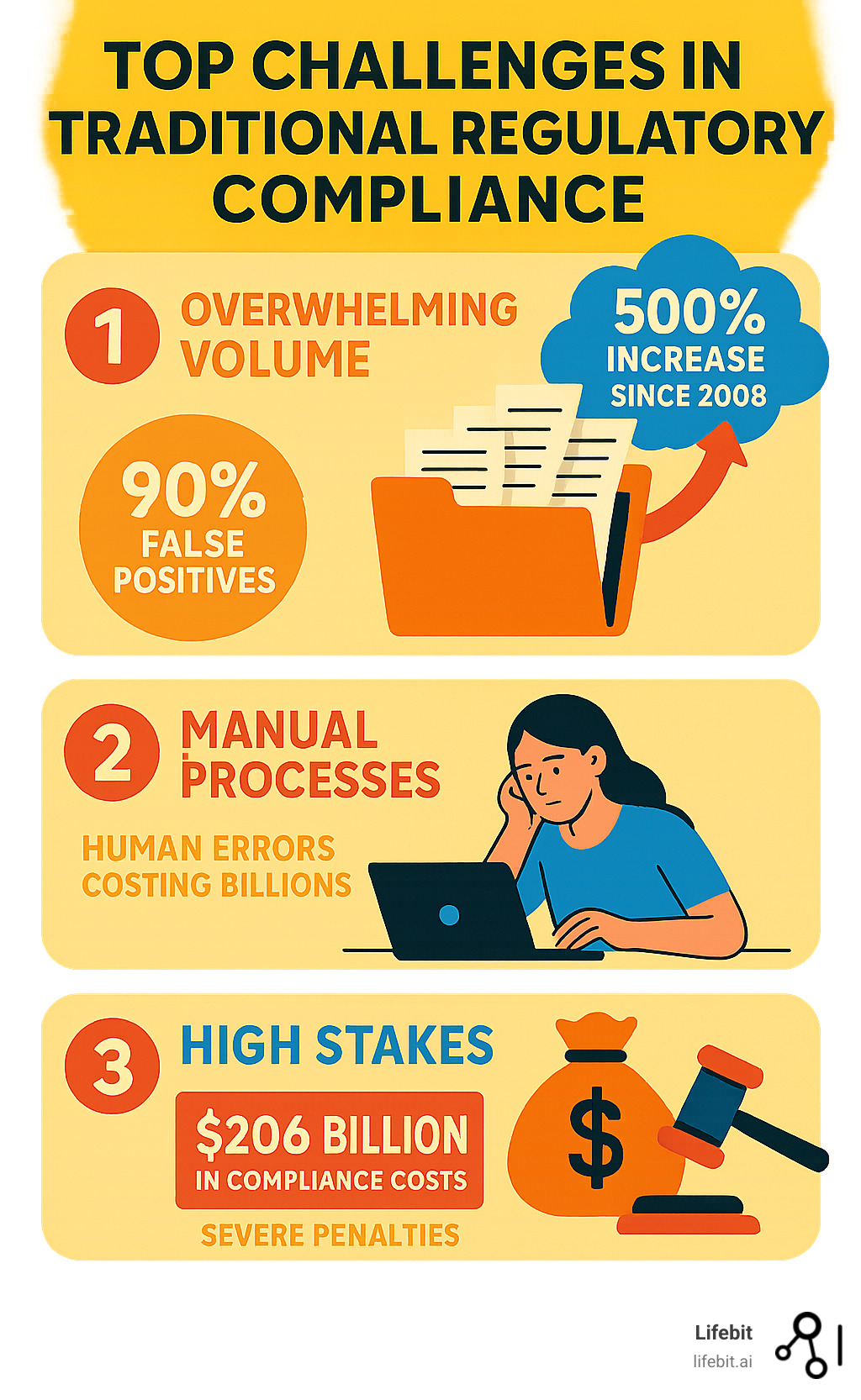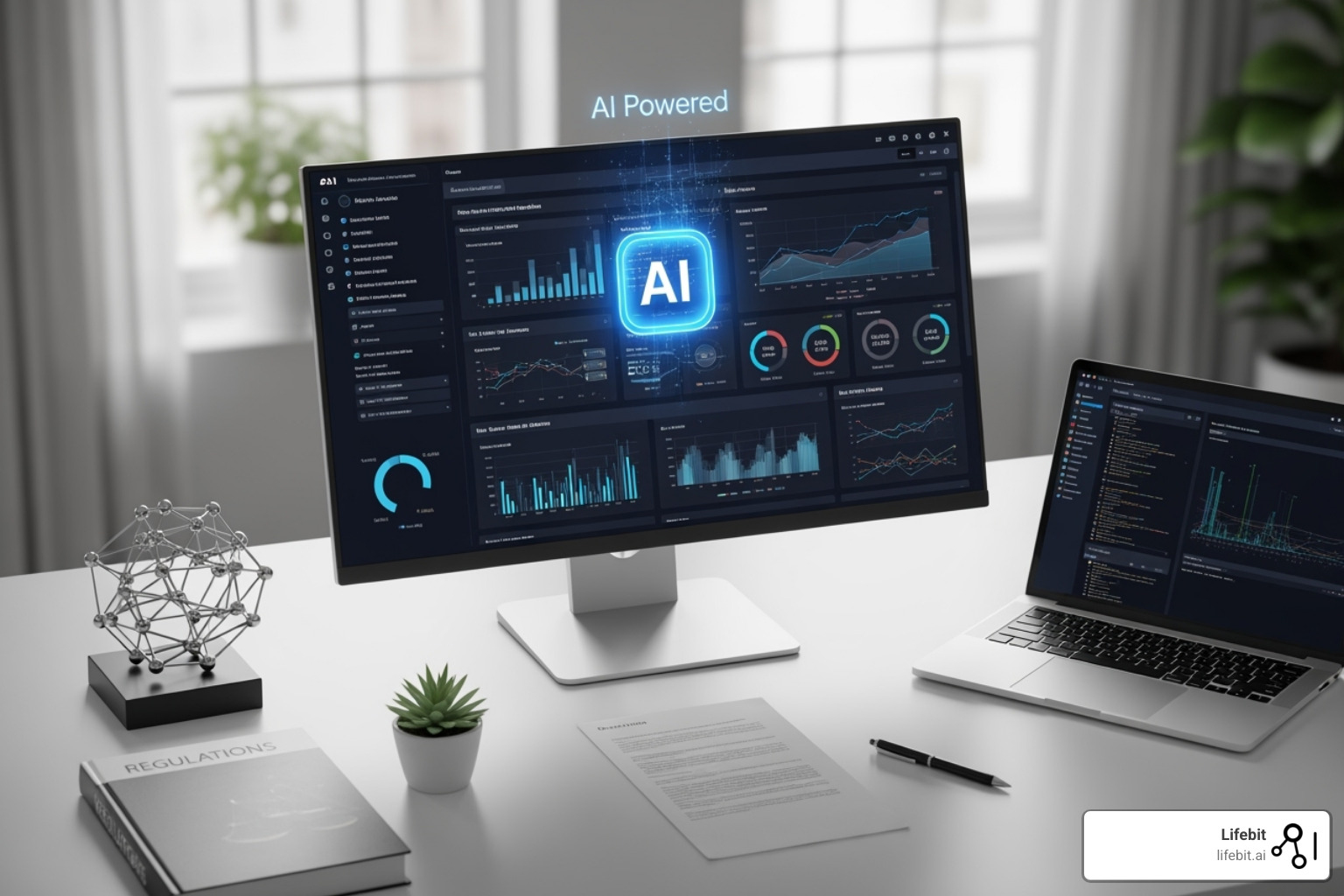AI and Regulatory Compliance—Because Rules Were Made to Be Followed

AI for regulatory compliance: Top 5 Strategic Advantages
Why AI for Regulatory Compliance is No Longer Optional
AI for regulatory compliance is changing how organizations steer the complex web of ever-changing regulations. Key applications include:
- Regulatory Change Management – Automatically monitor and interpret new regulations
- Risk Assessment – Predict compliance risks before they materialize
- Document Analysis – Process thousands of regulatory documents in minutes
- Real-time Monitoring – Track compliance status across all business units
- Automated Reporting – Generate audit-ready reports with complete data lineage
The numbers tell a stark story. Regulatory change has increased 500% since 2008, while financial crime compliance costs alone reached $206 billion in the past 12 months. Traditional manual processes cannot keep pace.
False-positive rates in compliance systems can exceed 90%, forcing teams to waste countless hours. Meanwhile, a single clerical error cost Citigroup nearly $1 billion.
This is where AI steps in. By automating routine tasks, analyzing patterns invisible to human eyes, and providing real-time insights, AI makes compliance proactive instead of reactive.
I’m Maria Chatzou Dunford, CEO and Co-founder of Lifebit. With over 15 years developing AI-powered platforms for highly regulated industries like genomics and healthcare, I’ve seen how AI for regulatory compliance can transform organizations from struggling with regulatory burden to gaining a competitive advantage through intelligent automation.

The Modern Compliance Conundrum: Why Traditional Methods Fall Short

For many compliance teams, the daily reality is a struggle against overwhelming regulatory documents, dense legal text that changes constantly, and the relentless pressure to avoid catastrophic errors. The traditional approach—manual processes and human-only oversight—can’t keep up with today’s landscape of data overload and evolving global regulations.
The numbers are staggering. Financial crime compliance costs reached $206 billion in the past year alone. This represents countless hours spent on tasks that could be automated and made more effective.
Despite this investment, false positives still plague compliance systems, sometimes exceeding 90%. Teams waste time chasing phantom threats while real risks slip through. The inefficiency is not just frustrating; it’s dangerous, and the reputational risk of failure can be devastating.
The Challenge of Volume and Velocity
Keeping up with regulatory updates is a monumental task. Since 2008, regulatory change has increased by 500%. The cross-jurisdictional complexity adds another layer of difficulty, as a single company may need to comply with regulations from dozens of countries. Consider a global financial institution: it must simultaneously adhere to the SEC’s rules in the US, the FCA’s regulations in the UK, ESMA’s directives in the EU, and MAS’s guidelines in Singapore, each with its own reporting cadence and nuances. A single product launch can trigger a cascade of compliance obligations across these jurisdictions.
Manual tracking of these changes is nearly impossible. By the time you’ve analyzed last month’s updates, new regulations have been published and existing ones amended. The time-consuming analysis required to understand each change creates a constant backlog, while the risk of missing critical changes grows daily.
The Problem with Manual Processes
Manual processes are prone to human error. We get tired, miss details, and can’t process information at the speed modern compliance demands. The high cost of human error in compliance can be astronomical. This relentless pressure leads to a state of compliance fatigue, where even the most diligent professionals become desensitized to alerts and prone to error, increasing risk and contributing to high employee turnover.
- High operational costs eat into budgets that could be better spent on strategic initiatives.
- The lack of scalability becomes obvious as a business grows; you can’t simply hire more people to read more documents.
- Inconsistent application of rules across departments creates gaps that regulators can exploit.
- Tedious, low-value tasks like data entry and document formatting consume energy that could be used for meaningful analysis.
- Talent drain and burnout: The tedious nature of manual compliance work leads to low morale and high turnover rates. Replacing a skilled compliance officer is expensive and time-consuming, creating knowledge gaps and further straining the remaining team.
The traditional approach is unsustainable. AI for regulatory compliance offers a way forward, changing these challenges into competitive advantages.
How AI Transforms the Regulatory Landscape

Instead of drowning in regulatory documents, what if your compliance team could predict what’s coming next? AI for regulatory compliance makes this possible by working smarter, not just faster. Generative AI can summarize thousands of pages of legal text into actionable intelligence or even draft initial versions of internal policies based on new regulations. Natural Language Processing (NLP) helps computers understand the nuances and intent of complex regulatory language, performing tasks like sentiment analysis on regulatory news to gauge enforcement trends. Meanwhile, Machine Learning (ML) improves at spotting risks with each new piece of data it processes, refining its predictive risk scoring models over time.
This is like having a brilliant assistant who never sleeps and remembers every regulation ever written. It can spot patterns across massive datasets that would take human teams months to identify, resulting in predictive analytics that warn you of compliance challenges before they arrive.
We’ve seen this change in drug findy, where AI-driven drug findy and compliance has revolutionized how companies steer complex regulatory pathways. The same principles apply across industries, turning compliance from a reactive scramble into a proactive strategy.
Key Applications of AI for Regulatory Compliance
- Regulatory Change Management: AI monitors global regulatory landscapes 24/7, automatically flagging new rules that affect your business and highlighting what matters most. This goes beyond simple alerts to include ‘horizon scanning,’ where AI proactively identifies proposed legislation and policy discussions, giving organizations a head start on future compliance requirements. It can automatically categorize updates by business impact, urgency, and relevant internal policies.
- Real-time Risk Assessment: Traditional systems often have false-positive rates over 90%. AI learns what’s normal for your organization and only alerts you to genuinely suspicious activity. It achieves this by building a dynamic, multi-dimensional baseline of ‘normal’ behavior for every customer, employee, and transaction. When an activity deviates significantly from this learned baseline—even if it doesn’t break a specific, pre-defined rule—the system flags it for human review, dramatically improving the quality of alerts.
- Automated Reporting: AI pulls data from multiple systems, validates it, and generates audit-ready reports with complete data lineage, turning weeks of work into hours. This includes generating complex reports like Suspicious Activity Reports (SARs) for financial institutions, adverse event reports for healthcare, and comprehensive compliance dashboards for executive oversight. AI ensures data integrity by automatically validating information against source systems and maintaining an immutable audit trail.
- Anti-Money Laundering (AML): For financial institutions, AI analyzes transaction patterns across millions of data points to identify subtle combinations that human analysts might miss. For example, AI can employ graph analytics to visualize and analyze complex networks of transactions, uncovering sophisticated money laundering rings that use multiple shell corporations and individuals to obscure the flow of funds. It can detect subtle techniques like ‘structuring,’ where large transactions are broken into smaller amounts to avoid reporting thresholds.
- Third-Party Risk Management (TPRM): AI scans news, financial reports, and other sources to spot red flags about your vendors and partners, continuously investigating your supply chain for compliance issues. Concrete red flags include negative media coverage indicating unethical practices, a vendor suddenly appearing on a sanctions list, abrupt changes in a partner’s corporate leadership or ownership structure, or financial instability revealed in public filings. AI provides continuous monitoring, a significant upgrade from periodic manual reviews.
- Pharmacovigilance: In healthcare, AI analyzes real-world data to detect adverse events and safety signals, helping companies maintain drug safety standards. AI can process vast amounts of unstructured data from sources that are impossible to monitor manually, such as social media posts, patient forums, electronic health records, and call center transcripts. By identifying patterns and keywords related to adverse events, it can surface potential safety signals much earlier than traditional methods.
From Reactive to Proactive: AI-Powered Risk Mitigation
AI flips the compliance model on its head, helping you see around corners instead of just reacting to problems.
- Predictive compliance uses historical data to forecast where your biggest risks lie, like a weather forecast for regulatory storms.
- Anomaly detection processes millions of transactions and data points to spot patterns indicating emerging problems, getting smarter over time to reduce false positives.
- Identifying emerging threats becomes possible as AI monitors regulatory texts, news, and enforcement actions to spot trends that signal new requirements.
- Scenario modeling lets you test “what if” situations, like a new regulation or market shift, to help you prepare for multiple possible futures.
- Dynamic policy management: AI can automatically cross-reference new regulations with your existing internal policies, highlighting gaps or contradictions and even suggesting updated language to ensure your internal controls remain aligned with external requirements.
The power of using real-world data for regulatory insights is immense. By analyzing actual outcomes, AI provides practical and actionable insights, changing compliance from a cost center into a strategic advantage.
How to Implement AI for Regulatory Compliance: A Step-by-Step Guide

Implementing AI for regulatory compliance is manageable with a structured approach. It requires a solid foundation of governance, data management, human oversight, and change management. Let’s walk through the steps.
Step 1: Assess Needs and Establish Governance
Before choosing an AI tool, assess your current struggles. Are you overwhelmed by false positives, missing regulatory updates, or struggling with reporting? Identify your pain points to define clear, measurable objectives, such as “reduce false positives by 60%.” A thorough pain point analysis involves asking targeted questions: Where are our biggest operational backlogs? Which manual task is most error-prone? Where do we face the highest risk of regulatory fines? What decisions require faster, more accurate data?
Next, form an oversight committee with legal, compliance, IT, and business unit representatives to guide decisions. This committee should be responsible for defining the AI strategy, approving use cases, overseeing ethical guidelines, and championing the initiative across the organization. It’s also critical to establish ethical guidelines. Only 18% of organizations have an enterprise-wide council for responsible AI governance. The importance of AI governance has never been more critical, and our experience with AI-Enabled Data Governance shows how foundational this step is.
Step 2: Prepare Your Data and Infrastructure
Your AI is only as smart as your data is clean. Start with data quality by cleaning, standardizing, and validating your data before feeding it to any AI system. This involves creating a comprehensive data dictionary, establishing clear data lineage to track information from its source, and implementing data governance frameworks. Data security is also existential. You need robust encryption, strict access controls, and secure storage to prevent breaches that could cost millions.
Data integration is another challenge, as compliance data often lives in multiple systems. This often requires a combination of modern APIs for new systems and robust ETL (Extract, Transform, Load) processes for legacy databases. The goal is to create a ‘single source of truth’ for compliance data to prevent conflicting information. Cloud infrastructure provides the necessary scalability, but it must be secure. At Lifebit, we’ve built our platform around secure, federated data environments. Understanding What is a Secure Data Environment (SDE)? is crucial. Furthermore, Ensuring your data is GDPR compliant is a legal requirement that can save you from massive penalties.
Step 3: Select and Deploy the Right AI Tools
Decide whether to build vs. buy. Building custom AI offers a perfect fit but requires significant resources. Buying off-the-shelf solutions is faster but may involve compromises. A third option is to partner with a specialized AI firm to co-develop a solution, blending external expertise with internal knowledge. Key criteria for selection include:
- Scalability: The solution must handle future growth in data and regulations.
- Integration capabilities: The tool must connect with your existing systems to avoid data silos.
- User-friendliness: Intuitive interfaces are essential for user adoption.
- Vendor vetting: Evaluate the company’s security, support, ethics, and track record.
When vetting vendors, dig deeper: ask about their model validation processes, their roadmap for adapting to future regulations, and their customer support model. Always start with pilot programs. Test thoroughly, gather user feedback, and refine your approach before a full-scale rollout. Define clear success metrics for the pilot, such as accuracy improvements or time saved, to build a strong business case for a full-scale rollout.
Step 4: Train Your Team and Foster Adoption
The human element is crucial. AI for regulatory compliance is about empowering your team, not replacing them. They bring context and judgment that AI cannot replicate.
- Upskilling your compliance officers: Teach them how to work with AI, understand its outputs, and know when to dig deeper. This means training them not just on the tool’s interface but on the principles behind the AI’s decisions.
- Human-AI collaboration: Let AI handle the heavy lifting while humans manage nuanced decisions and ethical oversight. This creates new, more valuable roles, such as the ‘Compliance AI Analyst’ or ‘AI Investigator,’ who validates high-stakes AI outputs, investigates the most complex alerts, and provides the final judgment call.
- Communicating benefits: Be honest about how AI will eliminate tedious tasks and free up time for strategic work.
- Continuous training and monitoring: Keep the team’s skills sharp and monitor performance to identify and fix issues early. It’s also vital to create a feedback loop: when a human expert corrects an AI’s finding, that correction should be fed back into the system to retrain and improve the model’s future performance.
Navigating the Minefield: Risks and Ethical Considerations

Implementing AI for regulatory compliance involves real risks and ethical considerations. More than half of compliance experts have concerns about data privacy, algorithmic transparency, and potential misuse. These are practical challenges that can make or break an AI implementation, but with the right approach, they are manageable.
The Challenge of Algorithmic Bias
AI systems can inadvertently perpetuate and amplify human biases. The technology isn’t inherently biased, but it learns from data. If that data reflects existing societal biases, the AI will too.
We’ve seen significant failures, such as Amazon’s biased AI recruiting tool that discriminated against women, and reports of bias in mortgage-approval algorithms. In compliance, this risk is even more serious. An AI might flag certain demographics as higher risk or under-report adverse events in specific patient populations, leading to severe legal and reputational consequences. A significant danger is proxy discrimination, where the AI learns to use seemingly neutral data points (like a person’s zip code or purchasing habits) as a stand-in for protected characteristics like race or income level.
The solution is a multi-pronged approach: actively curate and balance training data, potentially using synthetic data to fill gaps; implement technical fairness metrics (e.g., demographic parity, equalized odds) to test for disparities; and conduct regular, independent bias audits with diverse review teams.
Ensuring Transparency and Accountability
The “black box” problem occurs when AI models make decisions in ways that are difficult for humans to understand. In compliance, this is a major issue. Regulators and auditors require clear audit trails and explanations for how decisions are made.
Explainable AI (XAI) is crucial. We need systems that don’t just give answers but can also explain their reasoning. This involves using techniques that make model behavior understandable. For example, methods like LIME (Local Interpretable Model-agnostic Explanations) can explain why a single prediction was made (e.g., why this specific transaction was flagged), while SHAP (SHapley Additive exPlanations) can show the overall importance of different factors in the model’s decisions. The question of liability is also critical: when an AI errs, who is responsible? The vendor, the implementation team, or the executive who approved it? This requires clear contractual agreements with vendors that define responsibilities and robust internal governance policies that establish a clear chain of accountability for AI-driven decisions.
Building trust through responsible AI is about creating systems that stakeholders can understand. Human oversight remains essential for critical decisions.
Protecting Data Privacy and Security
AI systems are hungry for data, but in compliance, this data is often highly sensitive. The global regulatory landscape is a patchwork of laws, including Europe’s GDPR, the US’s HIPAA, the California Consumer Privacy Act (CCPA/CPRA), and Brazil’s LGPD, all carrying massive penalties for violations.
Robust data encryption, granular access controls, and data minimization are non-negotiable. Furthermore, organizations should explore advanced Privacy-Enhancing Technologies (PETs). Federated learning, for instance, allows AI models to be trained on decentralized data without the data ever leaving its secure location. Differential privacy adds statistical noise to data to protect individual identities while still allowing for aggregate analysis. These technologies are foundational to building trustworthy AI systems.
At Lifebit, our approach to preserving patient data privacy and security shows it’s possible to use AI while maintaining the highest data protection standards. Our Trusted Research Environment allows organizations to create secure spaces for AI-powered analysis. Security and privacy are not obstacles but the foundation for sustainable AI adoption.
Frequently Asked Questions about AI in Compliance
As we explore AI for regulatory compliance, several common questions arise. Here are some insights based on my experience.
Can AI completely replace human compliance officers?
No, and that’s a good thing. AI excels at data processing and pattern recognition but lacks the human ability for context, ethical judgment, and strategic thinking. Think of AI for regulatory compliance as a powerful assistant, not a replacement.
It handles repetitive, data-heavy tasks, freeing up your team to focus on strategic decision-making and applying their human expertise to complex scenarios. For example, AI might flag a transaction, but a human is needed to investigate the context and decide on the right action. AI as a powerful tool works best when augmenting human intelligence.
How do AI systems keep up with constantly changing regulations?
This is a key strength of AI. It uses several mechanisms to stay current:
- Continuous monitoring: AI systems constantly scan regulatory databases, legal publications, and news feeds.
- Real-time data feeds: These systems receive updates as soon as new regulations are published.
- Machine learning adaptation: The systems learn from new information, spot trends, and can even predict regulatory shifts.
- Natural Language Processing (NLP) for text analysis: NLP can read dense legal documents, extract key points, and compare regulations across jurisdictions.
What are the first steps for a small business to start using AI for compliance?
For smaller businesses, starting with AI doesn’t have to be overwhelming or expensive.
My golden rule is to start small. Don’t try to overhaul everything at once. Instead, identify repetitive tasks that consume your team’s time, like data validation or tracking specific updates. These are perfect for AI automation.
Cloud-based solutions are ideal, as many vendors offer subscription-based platforms that eliminate the need for costly hardware or specialized staff. The key is to assess needs honestly and focus on high-impact areas. Even small improvements can deliver significant cost savings and risk reduction, positioning your business to stay competitive.
The Future is Compliant: AI as a Strategic Advantage
The journey of AI for regulatory compliance is reshaping the competitive landscape. Instead of dreading the next regulatory update, your organization can welcome it, with AI systems having already prepared you for what’s coming. This isn’t science fiction; it’s the reality we’re moving toward.
The predictive capabilities of AI are becoming incredibly sophisticated, able to forecast regulatory changes and suggest strategic responses. This foresight transforms compliance from a cost center into a genuine competitive advantage.
Real-time monitoring is evolving toward autonomous systems capable of self-correction and continuous optimization. These “Cognitive Compliance Advisors” won’t just flag issues but will actively guide strategic decisions.
Furthermore, AI’s role in government enforcement is expanding. Agencies like the SEC, FDA, and DOJ are using AI to detect abuses and ensure compliance. This means organizations must be prepared for AI-powered regulatory scrutiny.
The numbers tell a compelling story. 72% of top-performing CEOs say competitive advantage depends on who uses the most advanced AI, and 78% of consumers believe organizations have a responsibility to develop AI ethically. This is about building trust and improving efficiency, not just avoiding fines.
At Lifebit, we are committed to this future. Our federated platform, including components like the Trusted Research Environment (TRE) and R.E.A.L. (Real-time Evidence & Analytics Layer), delivers real-time insights and AI-driven safety surveillance while ensuring secure collaboration.
Organizations that thrive will be those that view AI for regulatory compliance as a strategic opportunity, turning regulatory challenges into competitive advantages.
We invite you to explore how our secure, AI-ready platform can empower your organization to turn regulatory challenges into strategic opportunities. Explore Lifebit’s secure, AI-ready platform for compliant research.
The future isn’t just compliant—it’s intelligent, proactive, and competitive. The question isn’t whether AI will transform regulatory compliance, but whether your organization will lead the change.

